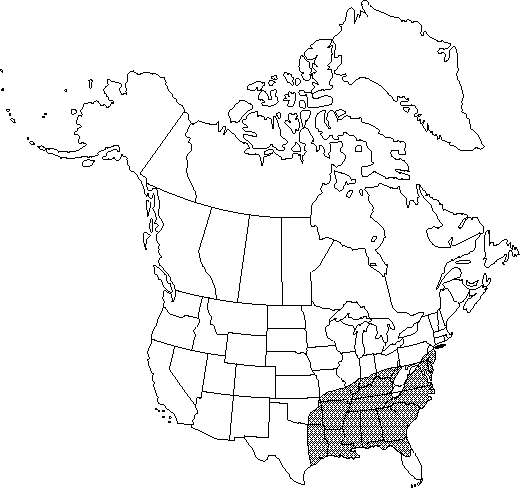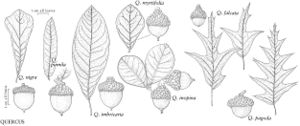Quercus falcata
Hist. Chênes Amér., no. 16, plate 28. 1801.
Trees, deciduous, to 30 m. Bark dark-brown to black, narrowly fissured with scaly ridges, inner bark orange. Twigs reddish-brown, (1-) 1.5-3.5 (-4.5) mm diam., pubescent. Terminal buds light reddish-brown, ovoid, 4-8 mm, puberulent throughout. Leaves: petiole 20-60 mm, glabrous to sparsely pubescent. Leaf-blade ovate to elliptic or obovate, 100-300 × 60-160 mm, base rounded or U-shaped, margins with 3-7 deep lobes and 6-20 awns, terminal lobe often long-acuminate, much longer than lateral lobes, apex acute; surfaces abaxially sparsely to uniformly tawny-pubescent, adaxially glossy and glabrous or puberulent along midrib, secondary-veins raised on both surfaces. Acorns biennial; cup saucer-shaped to cupshaped, 3-7 mm high × 9-18 mm wide, covering 1/3-1/2 nut, outer surface puberulent, inner surface pubescent, scale tips tightly appressed, acute; nut subglobose, 9-16 × 8-15 mm, often striate, puberulent, scar diam. 5-10 mm.
Phenology: Flowering spring.
Habitat: Dry or sandy upland sites
Elevation: 0-800 m
Distribution

Ala., Ark., Del., D.C., Fla., Ga., Ill., Ind., Ky., La., Md., Miss., Mo., N.J., N.Y., N.C., Ohio, Okla., Pa., S.C., Tenn., Tex., Va., W.Va.
Discussion
Native Americans used Quercus falcata in various ways to treat indigestion, chronic dysentery, sores, chapped skin, chills and fevers, lost voice, asthma, milky urine, and as an antiseptic, a tonic, and an emetic (D. E. Moerman 1986).
Quercus falcata reportedly hybridizes with Q. ilicifolia (= Q. ×caesariensis Moldenke), Q. imbricaria, Q. incana, Q. laevis, Q. laurifolia (= Q. ×beaumontiana Sargent), and Q. marilandica (E. J. Palmer 1948); with Q. nigra, and Q. pagoda (S. A. Ware 1967; R. J. Jensen 1989); and with Q. phellos, Q. shumardii, Q. hemisphaerica, and Q. velutina.
Selected References
None.
